Scant Job Growth During First Half Of 2012
Click here to view this report in Adobe Acrobat format.
(August 22, 2012) North Carolina’s labor market experienced little payroll employment growth during the first six months of 2012. Between December 2011 and June 2012, the state gained 22,700 more payroll jobs than it lost (+0.6 percent). Nearly 90 percent of that net gain originated in the private sector. Moreover, all of the year’s net job growth occurred during the first three months of 2012; in fact, the state actually lost more jobs than it gained during the year’s second quarter.
Given such weak growth, relatively little progress was made against unemployment. While the number of unemployed individuals and the statewide unemployment rate fell during the first half of 2012, those drops largely were intertwined with a 0.5 percent decline in the size of the state’s labor force. Compared to five years earlier, some 57,332 fewer North Carolinians were employed in June (-1.3 percent), while 227,531 more persons were unemployed (+107.4 percent).
Job Growth In 2012 Started Strong, Then Stalled
During the first six months of 2012, business establishments in North Carolina added 22,700 more payroll jobs than they shed (+0.6 percent). The private sector drove that growth by netting 20,400 positions (+0.6 percent), which amounted to 89.9 percent of the total gain. The public sector, meanwhile, gained 2,300 positions (+0.3 percent). That increase resulted from net hiring by local governments (+6,700 jobs, +1.5 percent), which was almost entirely offset by net reductions in state government payrolls (-4,000 jobs, -2.1 percent). With those changes, the number of local government payroll jobs in North Carolina was slightly beneath the level recorded in June 2008. Similarly, the total number of state government jobs in North Carolina in June 2012 was 3.6 percent lower than the level posted in the same month four years earlier.
Fig. 1 shows, the monthly pattern of job growth in 2012. When the monthly totals are grouped into calendar quarters, distinct patterns emerge. In Q1 (Jan.-Mar.), private payrolls gained 23,000 more positions than they lost (+0.7 percent), and public payrolls netted 4,200 jobs (+0.6 percent), leading to a net gain of 27,200 jobs (+0.7 percent). In Q2 (Apr.-Jun.), private-sector growth turned negative (-2,600 jobs, -0.1 percent), and public-sector employers shed 1,900 positions (-0.3 percent), resulting in a net loss of 4,500 jobs (-0.1 percent). The cumulative result was an overall six-month net gain of 22,700 jobs, all of which occurred in Q1.
The private-sector gains logged during the first half of 2012 did not occur uniformly across industries (fig. 2). The trade, transportation, warehousing, and utilities sector grew the most in absolute terms (+11,400 jobs, +0.3 percent); some 46 percent of the growth in the sector was attributable to the retail trade sub-sector (+5,200 jobs, +0.1 percent). The next largest net increase was found in the professional and business services sector (+8,700 jobs, +0.2 percent), with 79.3 percent of that growth originating in the professional, scientific, and technical services sub-sector. The finance sector contributed 5,700 jobs to the six-month net change, followed by the manufacturing and education and health services sectors (both +3,500 jobs.)
In terms of contracting private-sector industries, construction lost the most jobs in absolute and relative terms (-6,600 jobs, -0.2 percent), followed by other services (-4,700, -0.1 percent) and leisure and hospitality services (-2,200 jobs, -0.1 percent). Despite those losses, the leisure and hospitality services sector accounted for 10.1 percent of all private-sector jobs in North Carolina in June and was the source of 13 percent of all the private-sector jobs growth that took place from February 2010, the month when the state’s job market bottomed out, to June 2012.
Note that the industrial employment trends since the February 2010 onset of a labor market recovery are inconsistent with the claim that unemployment is the result of mismatches between workforce skills and job requirements. Some 53.4 percent of the net private-sector job growth recorded between February 2010 and June 2012 occurred in the accommodation and food services, retail trade, and administrative and waste management (including temporary help services) industrial sub-sectors; these are fields that generally employ significant numbers of workers with modest skill levels.
Large Job Gap Remains, Unlikely To Close Anytime Soon
The weak job growth recorded during the first half of 2012 did little to replace the jobs lost earlier in the business cycle. From the onset of the “Great Recession” in December 2007 through June 2012, North Carolina lost, on net, 221,800 positions, or 5.3 percent of its payroll employment base. The maximum job loss recorded during the business cycle occurred in February 2010, when the state had 326,300 fewer jobs (-7.8 percent) than it did 26 months before. Between then and June 2012, North Carolina netted 104,500 positions (+2.7 percent), for an average monthly gain of 3,732 jobs.
While the state’s economy netted more than two-thirds as many jobs in the first half of 2012 as it did in all of 2011 (+22,700 versus +33,300), the rate of job growth slowed over the course of the year and remains too weak to materially alter the employment situation. Even if the North Carolina labor market succeeded in adding another 22,700 jobs during the second half of 2012 and managed to replicate that gain every six months going forward, it would take until the first half of 2017 to close the jobs gap that existed in June, holding all else equal.
As fig. 3 shows, the job losses recorded during the Great Recession have proven more severe than the ones experienced during the 2001 and 1990-1991 recessions. At the height of the 2001 recession, the state lost 4.5 percent of its jobs base, while the comparable drop during the 1990-1991 recession was 1.9 percent. In both of those recessions, the job gap began to steadily close after the peak losses were realized. During the current cycle, however, the peak contraction was greater, and the recovery has been much slower.
To further understand the magnitude of the job gap facing North Carolina, consider how the state had only 18,300 more payroll jobs (+0.5 percent) in June 2012 than it had in June 2000, despite having a much larger economy. Between 2000 and 2011, the last year with complete data, economic output in North Carolina rose by 21.6 percent in inflation-adjusted terms. Moreover, the state has regained all of the economic output lost earlier in the Great Recession, and the statewide economy was, in real terms, 1.7 percent larger in 2011 than it was in 2007. Such growth, however, has neither sparked job growth nor boosted average living standards.
Remember, too, that the job shortfall facing North Carolina is actually larger than the one caused by the destruction of jobs during the recession. Between December 2007 and June 2012, the number of working-age persons increased by 534,724 persons (+7.7 percent). This means that payroll employment in the state should have been growing at an average monthly rate of 0.1 percent to keep pace. If one considers the jobs that should have been created since December 2007 but were not, the job gap facing the state in June 2012 equaled 555,700 positions (fig. 4).
To close that gap by December 2015, holding all else equal, North Carolina would need to net 13,231 jobs per month for each of the next 42 months — an average monthly net gain 3.5 times greater than the one experienced between February 2010 and June 2012. At no point since 1990 has North Carolina sustained such growth for so long. In fact, North Carolina has netted at least 13,200 payroll jobs in just 42 of the 258 months (16.3 percent) stretching from January 1990 to June 2012.
Joblessness Remains Widespread
Weak job growth during the first half of 2012 did little to reduce the problems of unemployment and joblessness in North Carolina. The monthly number of unemployed Tar Heels (seasonally adjusted) averaged 451,134. Unemployment was higher in both absolute and relative terms during the first quarter of the year than in the second quarter. From December 2011 to June 2012, the statewide unemployment rate fell from 10.4 percent to 9.4 percent, which was the lowest level recorded since early 2009. That said, unemployment remained elevated by any objective measure. In June 2007, for instance, the statewide unemployment rate was half as high as the rate posted in June 2012 (4.7 percent versus 9.4 percent), and the total number of unemployed persons was 51.8 percent smaller.
When judged in terms of the statewide unemployment rate (seasonally unadjusted), the recent recession has proven to be the longest and most severe of any post-1980 downturn (fig. 5). Between 1980 and 2008, the highest unemployment rate recorded in North Carolina was 11.3 percent in March 1983. During the same 28-year period, the unemployment rate exceeded 10 percent in four months, all in the early 1980s. Since February 2009, however, the seasonally unadjusted unemployment rate has exceeded 10 percent in 35 of 41 months and has fallen no lower than 9.4 percent.
In every other post-1980 recession, the state unemployment rate had returned to its pre-recessionary level by 45 months following the onset of the downturn. Despite the passage of 54 months since the onset of the last recession (as of June 2012), North Carolina’s seasonally unadjusted unemployment rate of 9.4 percent was 4.5 percentage points higher than the December 2007 level of 4.9 percent.
Unemployment One Labor Market Problem Among Many
The size of the state’s civilian labor force (seasonally adjusted) contracted by 21,849 individuals (-0.5 percent) between December 2011 and June 2012. Compared to a year earlier, the state’s labor force had just 5,878 more individuals (+0.1 percent), even though the number of working-age people in the state had grown by 78,908 individuals, or 1.1 percent (fig 6).
An important reason why the size of the labor force has held relatively constant despite steady growth in the population of working-age people is the sharp drop in the labor force participation rate, which measures the share of the working-age population that is employed or unemployed.
In June 2012, the state’s seasonally adjusted labor force participation rate equaled 62.1 percent. While this level was up slightly compared to the June 2011 level of 61.9 percent, it remains close to the 36-year low of 61.6 percent set earlier in the downturn. The depressed labor force participation rate indicates that many people of working age are not participating in the labor market, either by choice (e.g., retirees, homemakers, and students) or due to discouragement. This suggests that joblessness is more widespread than reflected in the official unemployment rate.
To put the depressed labor force participation rate in context, consider how the rate equaled 67.5 percent in June 2000. If the rate had held constant, the number of employed and unemployed persons residing in North Carolina in June 2012 would have totaled 5,049,238 — a number 8.2 percent greater than the actual figure of 4,665,387. While the labor force participation rate likely should have dropped to some degree over the past 12 years owing to demographic effects, the magnitude of the drop suggests that cyclical factors are at play.
Two additional measures help to illustrate the extent to which labor currently is sitting idle in North Carolina. The first measure is the employment-to-population ratio, which reflects the share of the working-age population that is employed. In June 2012, the employment-to-population ratio in North Carolina was 56.1 percent, down from the 56.3 percent rate recorded in December 2011 but up from the 55.8 percent figure posted one year earlier.
While the employment-to-population ratio has increased somewhat from the extraordinary low level of 55.3 percent experienced in the third quarter of 2011, the ratio remains near that 36-year low (fig. 7). If the rate in June 2012 had equaled the June 2000 one of 65 percent, holding all else constant, the number of employed persons residing in North Carolina would have totaled 4,862,229 — a figure 15.3 percent greater than the actual figure of 4,216,014.
The second important measure is the underemployment rate, which is a broader gauge of labor under-utilization prepared quarterly by the US Bureau of Labor Statistics. This statistic captures the share of the state’s adjusted labor force that was unemployed, working part-time despite wanting full-time work, or marginally attached to the workforce (due to discouragement or other reasons). During the second quarter of 2012, North Carolina’s underemployment rate equaled 17.5 percent, down slightly from the 17.6 percent rate posted in the first quarter of the year.
Regardless of the exact measure used, a sizable amount of labor in North Carolina was sitting idle in June. Slightly more than nine of every 100 members of the state’s labor force were unemployed (seasonally adjusted), while more than 17 of every 100 persons in the adjusted labor force were underemployed. Compared to 12 years ago, more North Carolinians were unemployed in both absolute and relative terms in June, and smaller shares of the working-age population were employed or were even participating in the labor force.
The fundamental reason why so many potential workers are sitting on the labor market’s sidelines is a lack of jobs. According to the Job Openings and Labor Turnover Survey conducted by the US Bureau of Labor Statistics, the ratio of unemployed adults to available job openings in June 2012 in the South was 3-to-1 (state-level data are unavailable). In short, there simply were no jobs for two of every three unemployed Southerners in June.
Geographic Patterns In Joblessness
During the first half of 2012, labor market conditions remained weak across North Carolina. In June 2012, 61 counties had unemployment rates of at least 10 percent. Compared to a year earlier, unemployment rates were lower in 91 counties, higher in six counties, and unchanged in three counties. (All local figures are seasonally unadjusted.)
Labor markets in non-metropolitan communities remained particularly weak during the first part of 2012. In June 2012, the unemployment rate in non-metropolitan North Carolina was 10.9 percent, down from the 11.9 percent rate recorded one year earlier. The metropolitan unemployment rate also fell over the course of the year, dipping to 9.4 percent from 10.5 percent. Meanwhile, 9.2 percent of the combined labor force residing in the “Big Three” metro areas of Charlotte, the Research Triangle, and the Piedmont Triad was unemployed.
From the onset of the recession until June 2012, the size of North Carolina’s non-metro labor force declined by 5,697 individuals (-0.4 percent), while the metropolitan labor force gained 201,217 members (+6.4 percent). Within metro North Carolina, growth in the “Big Three” metros accounted for 70.9 percent of the total gain.
As fig. 8 shows, the labor market performances of North Carolina’s metro areas varied over the year. Eleven of the state’s 14 areas recorded increases in their labor forces, with the greatest gains occurring in the Raleigh-Cary (+3.1 percent) and Jacksonville (+2.3 percent) metros. In contrast, Wilmington’s labor force shrank by 2.2 percent, followed by the Hickory-Morganton-Lenoir and Greenville metros (both -0.1 percent). Since the start of the recession, the greatest rates of labor force growth have occurred in the military communities of Jacksonville (+13.7 percent) and Fayetteville (+12.5 percent), followed by Raleigh (+10 percent) and Asheville (+6.6 percent).
At 7.9 percent, Asheville and Durham-Chapel Hill tied for the lowest metro unemployment rate in June 2012. Next came Raleigh (8 percent), Goldsboro (9 percent), Jacksonville (9.2 percent), and Winston-Salem (9.3 percent). The highest rates were in Rocky Mount (13.2 percent), Hickory (11.2 percent), and Greenville (10.6 percent).
When looking at local unemployment numbers, it is important to place them in perspective. The 7.9 percent unemployment rate found in the Asheville metro in June, for instance, was low relative to the performance of other North Carolina metros, yet it is was high by any objective standard. Consider how in June 2008 just 4.8 percent of Asheville’s labor force was unemployed. Four years later, the area’s unemployment rate was 3.1 percentage points higher, while the number of unemployed residents was 69.2 percent larger. Despite faring better than other metros in the state, Asheville’s labor market hardly can be called robust.
Economic Hardships Continue To Mount
As mentioned previously, a lack of jobs continues to be the most serious problem facing working North Carolinians. Given the depressed demand for labor and the relative scarcity of job openings, it is not surprising that individuals who have lost jobs are experiencing prolonged bouts of unemployment.
In June 2012, 41.9 percent of all unemployed Americans had been jobless for at least six months, with the average spell of unemployment lasting 39.9 weeks. Unfortunately, the longer workers are unemployed, the less likely they are to secure new positions due to competition, skills deterioration, and employer stereotyping. If the trends continue, many of North Carolina’s long-term unemployed probably will never regain work.
Due to the length of the recession, many of the long-term unemployed increasingly have been left to their own devices. Nationwide, only about 46 percent of unemployed Americans receive unemployment insurance payments, according to estimates from the National Employment Law Project, and many of those who are fortunate enough to receive insurance payments are facing payment reductions.
Congressional decisions related to the provision of emergency and extended insurance payments beyond the 26-week maximum payment period common in North Carolina and most states mean that most forms of emergency and extended benefits will lapse by year’s end. The maximum number of weeks of state and federal insurance payments available to North Carolinians already has fallen to 79 weeks from 99 weeks due to changes in the Extended Benefits (EB) Program — changes that reduced insurance for some 22,500 North Carolinians. Moreover, the entire Emergency Unemployment Compensation (EUC) Program will expire at the end of 2012. Other changes to the EUC program ensure that eligible workers will receive fewer weeks of compensation than earlier in the recession and that no one who loses a job after July 2012 will receive any supplemental insurance.
Perhaps the most troubling indicator of the economic hardships facing North Carolina’s households is the surge in the size of the state’s Supplemental Nutrition Assistance Program (SNAP) caseload. Between December 2007 and May 2012, the most recent month with data, the number of Tar Heels participating in the program grew by 79.1 percent, or 730,285 persons (fig. 9). Much of the growth is attributable to job losses among individuals with modest incomes — job losses that pushed their household incomes below the program eligibility level (gross monthly income of 130 percent of the poverty level, or $2,422 for a four-person household). As a result, 17.1 percent of the state’s residents were connected to the food assistance program in May.
A Cloudy Horizon
Thus far, 2012 has proven to be a disappointing year for North Carolina’s labor market, which, through June, had gained only 22,700 more jobs than it lost. While the private sector performed relatively well during the year’s first quarter, at least by recent standards, it contracted during the second quarter. That said, the current overall rate of growth in the state’s job market simply is insufficient to close the large job gap anytime soon. Some 4.5 years after the onset of the Great Recession, a full recovery remains years away.
Absent a surge in the second half of the year, North Carolina’s labor market will continue to sputter. While payrolls likely will inch upward with some level of net growth occurring in most private industrial sectors, jobs should remain scarce. That means the problems of abnormally high levels of unemployment and underemployment will remain, so economic hardships should remain pronounced across the state.
For the long-term unemployed, their odds of returning to work will continue to drop, yet the tattered state of the nation’s safety net means that little help will be available for such individuals. Moreover, the relative indifference of policymakers to the ill health of the labor market combined with an inexplicable insistence on pursuing contractionary policies will exacerbate the problems facing North Carolinians who want and need work.
North Carolina’s labor market currently is on pace to perform better than it did in 2011, yet such relative progress simply is not good enough in light of the problems facing the state. Consequently, 2012 is on track to become the fifth consecutive year of minimal or negative job growth in North Carolina.
###
Individuals with a printed copy of this analysis may access it online at http://www.sbnstrategies.com/?p=11589 or by scanning the QR code below.
All material within this analysis Copyright © 2012 by South by North Strategies, Ltd. All rights reserved.

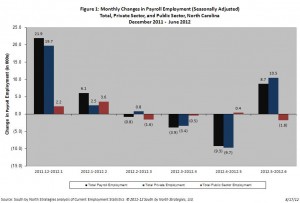
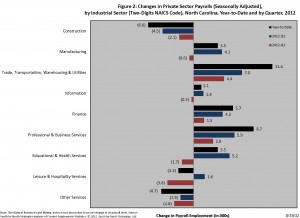
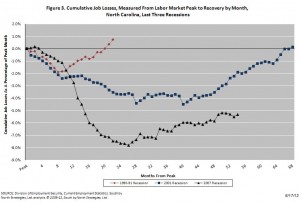
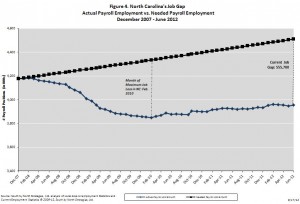
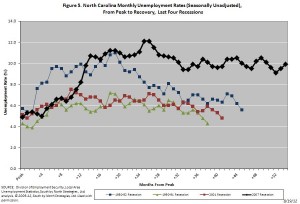
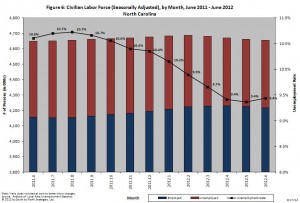
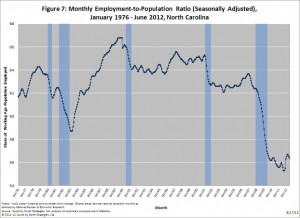
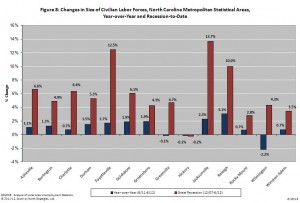
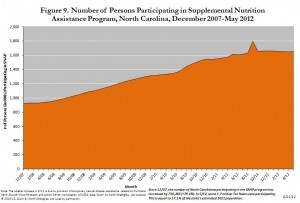


 Email Sign-Up
Email Sign-Up RSS Feed
RSS Feed